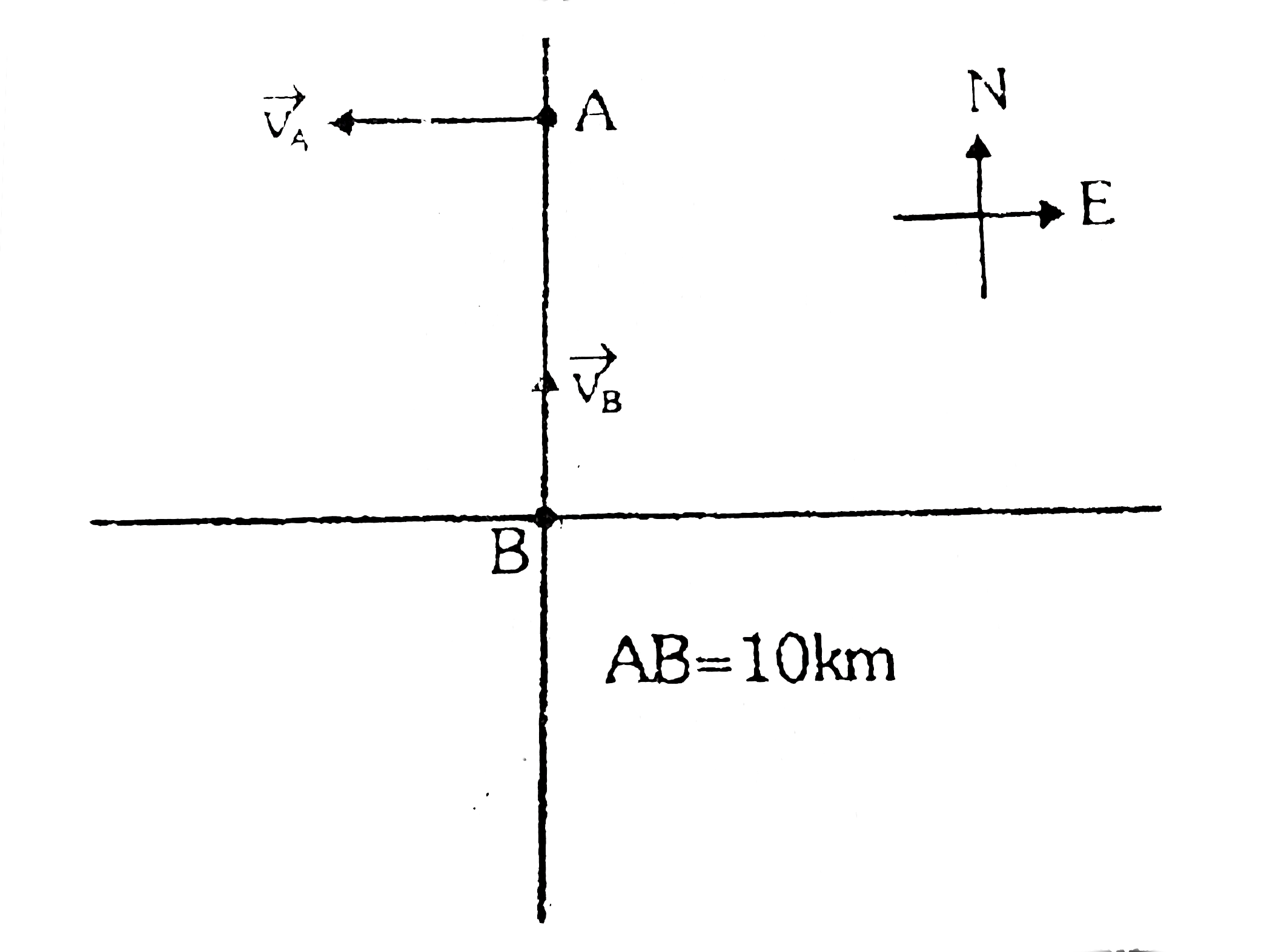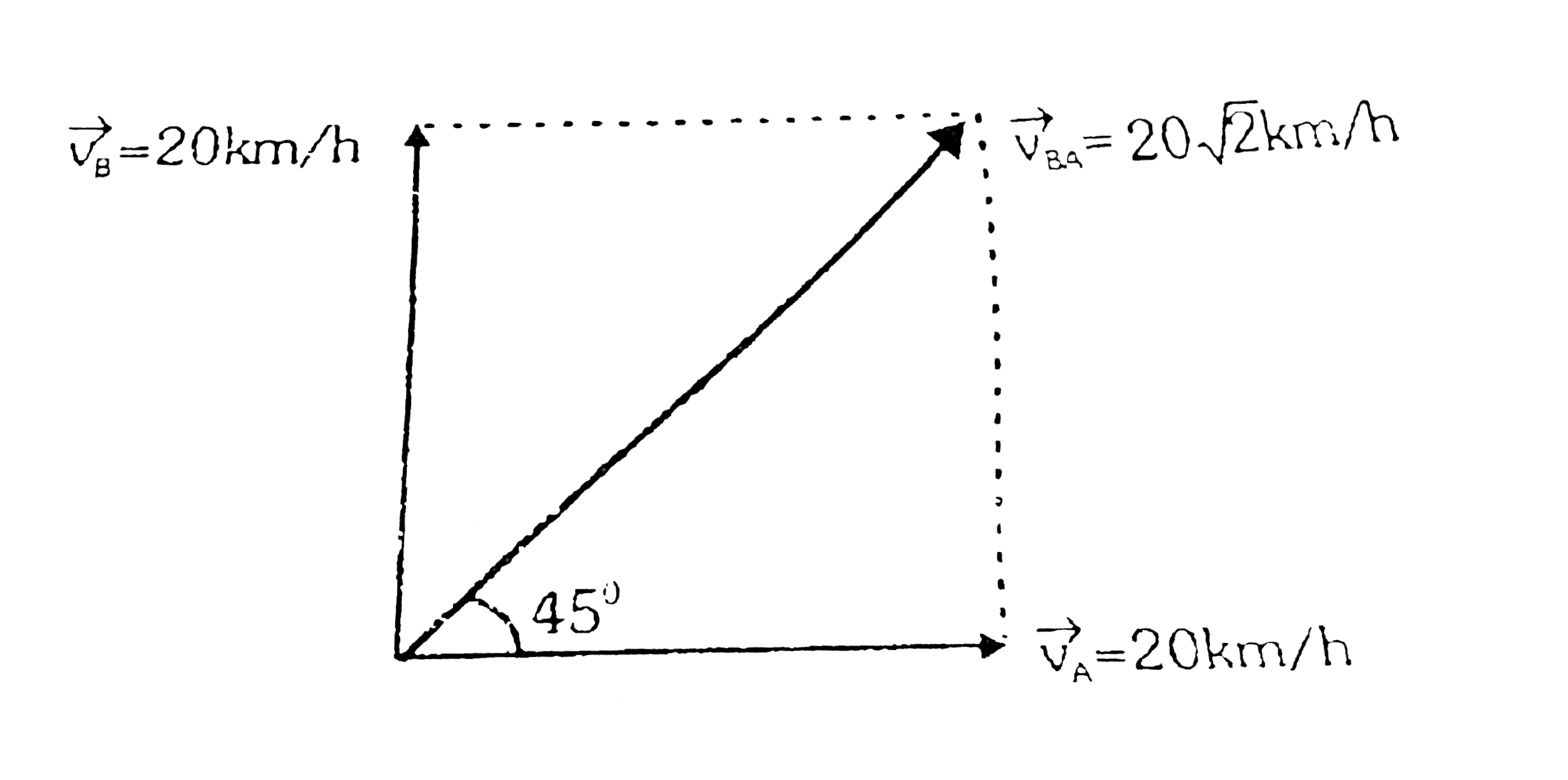A ball is projected vertically up wards with a velocity of 100 m/s. Find the speed of the ball at half the maximum height. (g=10m/s2) Solution in Gujrati
Ships a and b are moving with same speed 20km/h in the direction shown in figure. It is a two dimensional, two body problem with zero acceleration. Let us find →vBA

→vBA=→vB−→vA
Here, |→vBA|=√(20)2+(20)2=20√2km/h
i.e., →vBA is 20√2km/h at an angle of 45∘ from east
towards north. Thus, the given problem can be simplified as :

A is at rest and B is moving with →vBA in the direction shown in figure.
Therefore, the minimum distance between the two is ltbtgt smin=AC=ABsin45∘=10(1√2)km=5√2km
and the desired time is t=BC|→vBA|=5√220√2=14h=15 min

Topper's Solved these Questions
- MOTION IN A PALNEBOOK - ALLEN CHAPTER - MOTION IN A PALNEEXERCISE - EXERCISE-02
37 Videos
- MOTION IN A PALNEBOOK - ALLEN CHAPTER - MOTION IN A PALNEEXERCISE - EXERCISE-03
6 Videos
- KINEMATICS-2DBOOK - ALLEN CHAPTER - KINEMATICS-2DEXERCISE - Exercise (O-2)
47 Videos
- NEWTON'S LAWS OF MOTION & FRICTIONBOOK - ALLEN CHAPTER - NEWTON'S LAWS OF MOTION & FRICTIONEXERCISE - EXERCISE (JA)
4 Videos
Similar Questions
The distance x of a particle moving in one dimensions, under the action of a constant force is related to time t by the equation, t=√x+3, where x is in metres and t in seconds. Find the displacement of the particle when its velocity is zero.
View SolutionA point traversed half the distance with a velocity v0. The remaining part of the distance was covered with velocity v1 for half the time, and with velocity v2 for the other half of the time. Find the mean velocity of the point averaged over the whole time of the motion.
View SolutionA particle is moving in xy-plane .At certain instant the components of its velocity and acceleration are as follows ux=3m/s,uy=4m/s,ax=2m/s2anday=1m/s2. The rate of change of speed at this moment is
View SolutionA piece of wire is bent in the shape of a parabola y=kx2 (y-axis vertical) with a bead of mass m on it. The bead can slide on the wire without friction. It stays at the lowest point of the parabola when the wire is at rest. The wire is now accelerated parallel to the x-axis with a constant acceleration a. The distance of the new equilibrium position of the bead, where the bead can stay at rest with respect to the wire, from the y-axis is:
View SolutionA ball is thrown up at a speed of 4.0 m/s. Find the maximum height reached by the ball. Take g=10m/s2.
View SolutionA ball is projected vertically upward with speed of 50 m/s. Find a. the maximum height, b. the time to reach themaximum height, c. the speed at half the maximum height. Take g= 10 m/s^2 .
View SolutionA ball is projected vertically upward with a speed of 50 m//s. Find (a) the maximum height, (b) the time to reach the maximum height, (c) the speed at half the maximum height. Take g=10 ms^2.
View SolutionA ball is throw vertically upward. It has a speed of 10m/s when it has reached one half of its maximum height. How high does the ball rise ? (Taking g=10m/s2).
View SolutionA ball is thrown vertically upward attains a maximum height of 45 m. The time after which velocity of the ball become equal to half the velocity of projection ? (use g = 10 m/s2)
View SolutionA ball is projected vertically up with a speed of 50 m/s. Find the maximum height , the time to reach the maximum height, and the speed at the maximum height (g=10m/s2)(AS1)
View SolutionA ball is projected vertically up with a speed of 50 m/s. Find the maximum height , the time to reach the maximum height, and the speed at the maximum height (g=10m/s2)(AS1)
View SolutionA ball is projected vertically up with a speed of 50 m/s. Find the maximum height , the time to reach the maximum height, and the speed at the maximum height (g=10m/s2)(AS1)
View SolutionA ball is projected vertically up with a speed of 50 m/s. Find the maximum height , the time to reach the maximum height, and the speed at the maximum height (g=10m/s2)(AS1)
View SolutionA ball is projected vertically up with a speed of 50 m/s. Find the maximum height , the time to reach the maximum height, and the speed at the maximum height (g=10m/s2)(AS1)
View SolutionA ball is projected vertically up with a speed of 50 m/s. Find the maximum height , the time to reach the maximum height, and the speed at the maximum height (g=10m/s2)(AS1)
View SolutionA ball is thrown up at a speed of 4.0 m/s. Find the maximum height reached by the ball. Take g=10m/s2.
View Solution
